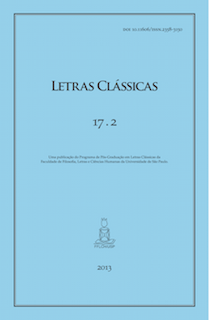Exempla di δίδαξις nel mondo animale: il caso dell’ ἀράχνη
DOI:
https://doi.org/10.11606/issn.2358-3150.v17i2p63-76Palavras-chave:
Plutarco, Cheronese, zoologia, etologia, símbolo, ἀράχνηResumo
Na história humana, a importância do animal como objeto cultural não foi muito inferior à do animal stricto sensu. O animal é “muito bom” de ser estudado, não só pelas complexas interações estabelecidas com o mundo humano, mas também por sua importância como representação no imaginário das tradições culturais das sociedades antigas e modernas. Como se sabe, depois de Aristóteles a zoologia se tornou etologia; o retorno do animal a suas funções simbólicas e arcaicas poderia explicar a complexidade das obras científicas de Plutarco, baseadas em diferentes competências: zoológica, científica, anedótica, mas também retórica e filosófica. A análise das virtudes atribuídas ao mundo animal feita por Cheronese revela que muitas vezes eles são descritos para commovere o público. Há diversas observações a respeito da utilização e da reutilização do repertório zoológico em Plutarco. A polivalência semântica do animal é aqui irrefutável: em Plutarco, o animal pode ser objeto de um estudo pseudocientífico, um símbolo, uma metáfora, uma símile, um instrumentum usado para refutar ideias e persuadir o leitor.Downloads
Os dados de download ainda não estão disponíveis.
Downloads
Publicado
2013-11-28
Edição
Seção
Artigos
Licença
Autores que publicam nesta revista concordam com os seguintes termos:
- Autores mantém os direitos autorais e concedem à revista o direito de primeira publicação, com o trabalho licenciado simultaneamente sob uma Licença Creative Commons Attribution 2 anos após a publicação, permitindo o compartilhamento do trabalho com reconhecimento da autoria do trabalho e publicação inicial nesta revista.
- Autores têm autorização para assumir contratos adicionais separadamente, para distribuição não-exclusiva da versão do trabalho publicada nesta revista (ex.: publicar em repositório institucional ou como capítulo de livro), com reconhecimento de autoria e publicação inicial nesta revista.
- Autores têm permissão e são estimulados a publicar e distribuir seu trabalho online (ex.: em repositórios institucionais ou na sua página pessoal) a qualquer ponto antes ou durante o processo editorial, já que isso pode gerar alterações produtivas, bem como aumentar o impacto e a citação do trabalho publicado (Veja O Efeito do Acesso Livre).
Como Citar
Guarino, G. (2013). Exempla di δίδαξις nel mondo animale: il caso dell’ ἀράχνη. Letras Clássicas, 17(2), 63-76. https://doi.org/10.11606/issn.2358-3150.v17i2p63-76


